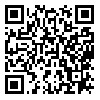شمارۀ جدید فصلنامه (پاییز1404) منتشر شد
Volume 12, Issue 1 (4-2021)
Social Problems of Iran 2021, 12(1): 63-84 |
Back to browse issues page
Download citation:
BibTeX | RIS | EndNote | Medlars | ProCite | Reference Manager | RefWorks
Send citation to:



BibTeX | RIS | EndNote | Medlars | ProCite | Reference Manager | RefWorks
Send citation to:
Shirdel E, Hamikargar F, Morad Khani M. (2021). A Phenomenological Study of the Health-Based Lived Experience of the Youth of Sistan and Baluchestan in the COVID-19 Crisis. Social Problems of Iran. 12(1), 63-84. doi:10.52547/jspi.12.1.63
URL: http://jspi.khu.ac.ir/article-1-3251-en.html
URL: http://jspi.khu.ac.ir/article-1-3251-en.html
1- Assistant Professor, Department of Social Sciences, Faculty of Literature and Humanities, Sistan and Baluchestan University , eshirdel@lihu.usb.ac.ir
2- student in Sociology, Faculty of Humanities, Kashan University
3- Master of Women Studies, Faculty of Social Sciences, Shiraz University
2- student in Sociology, Faculty of Humanities, Kashan University
3- Master of Women Studies, Faculty of Social Sciences, Shiraz University
Abstract: (2342 Views)
The emergence of the corona pandemic in various countries, including Iran, make changes both at the macro and structural levels and at the interpersonal interactions and micro-levels, including health-oriented behaviors of people. This research studied with a qualitative approach and descriptive phenomenology methodology the mental meaning and lived experience of the youth of Sistan and Baluchestan province of health in the first wave of the Covid-19 epidemic. The number of 40 youths from Sistan and Baluchestan selected by a purposive sampling method and information was collected using a semi-structured interview tool and analyzed by the Colaizzi method. The pattern of common themes resulting from the analysis of the health-centered lived experience of the youth of Sistan and Baluchestan during the Corona Crisis includes two main themes, four sub-themes, and 34 primary themes. The central theme of "Lack of social health responsibility and endangering public health" is derived from two sub-themes: "Negative reactions to health outbreaks in epidemics" and "Neglectful actions and disregard for collective health." Another prominent theme is the "Dissemination of a health-oriented lifestyle with the Covid-19 epidemic." This theme has emerged of two sub-themes: "Selecting health-oriented patterns in life" and "media influence and spreading health-oriented awareness." In the first wave, with the advent of the Covid-19 epidemic, young people experienced both the spectrum of social irresponsibility and the risk of collective infection to media consumption and a health-oriented lifestyle, which prevents social coherence for achieving collective health and relief from this crisis.
Type of Article: Original Research |
Received: 2020/09/8 | Accepted: 2021/04/13 | Published: 2021/04/13
Received: 2020/09/8 | Accepted: 2021/04/13 | Published: 2021/04/13
References
1. اسکندریان، غلامرضا (1399). ارزیابی پیامدهای ویروس کرونا بر سبک زندگی (با تاکید بر الگوی مصرف فرهنگی)، ارزیابی تاثیرات اجتماعی، 1(2 ) : 85-65.
2. امامی سیگارودی، عبدالحسین؛ دهقان نیری، ناهید؛ رهنورد، زهرا و نوری سعید، علی (1391). روش¬شناسی تحقیق کیفی: پدیدارشناسی، فصلنامه پرستاری و مامایی جامعه¬نگر، 22(68) : 63-56.
3. بازرگان، مهدی و امیرفخریان، مصطفی (1399). تحلیل جغرافیایي اپیدمیولوژی کووید-91 در ایران با رویکرد تحلیل اکتشافي داده¬های مکاني ESDA))، فصل¬نامه طب نظامی، 22(6): 552-542.
4. تاج¬بخش، علیرضا (1399). واکاوی سبک نوین زندگی عصر پسا کرونا، فصلنامه مطالعات راهبردی سیاستگزاری عمومی، 10(35): 360-340.
5. تاجری مقدم، مریم؛ زبیدی، طاهره و یزدانپناه، مسعود (1399). تحلیل رفتارهای پیشگیرانه در مقابله با ویروس کرونا مورد: نواحی روستایی شهرستان دشتستان، فصلنامه اقتصاد فضا و توسعه روستایی، 9(3): 24-1.
6. فتحی، الهام (1395). بررسي روند تغييرات ساختار و تركيب جمعيت كشور و آينده آن تا افق 1430 بر اساس نتايج سرشماري عمومي نفوس و مسكن 1395، دفتر جمعيت، نيروي كار و سرشماري گروه جمعيت و سلامت، مرکز آمار ایران.
7. لعلی، محسن، عابدي، احمد و کجباف، محمدباقر. (1391). ساخت و اعتباریابی پرسشنامه¬ي سبک زندگی، فصل¬نامه پژوهش¬هاي روانشناختی، 15(1): 80-64.
8. مسعودنیا، ابراهیم. (1389). جامعه¬شناسی پزشکی(چاپ اول). تهران: موسسه انتشارات دانشگاه تهران.
9. Abel, T. (1991). Measuring hearth lifestyle in comparative analysis: theoretical issues and empirical findings, Soc Sci Med, 32(8): 899- 908. [DOI:10.1016/0277-9536(91)90245-8]
10. Abel, T. Cockerham, W.C., Niemann , S. (2000). A critical approach to lifestyle and health ,Researching Health Promotion Routledge, London.
11. Abrutyn. S., Mueller, A.S.(2014). Are suicidal behaviors contagious in adolescence? Using longitudinal data to examine suicide suggestion. Am Sociol Rev.79(2):211-227. [DOI:10.1177/0003122413519445]
12. Anwar, A., Malik, M., Raees, V., Anwar, A. (2020) Role of Mass Media and Public Health Communications in the COVID-19 Pandemic. Cureus , 12(9): e10453. [DOI:10.7759/cureus.10453]
13. Balanzá-Martínez , V., Atienza-Carbonell, B., Kapczinski, F., and De Boni, RB.(2020). Lifestyle behaviors during the COVID-19 - time to connect. Acta Psychiatr Scand ,141(5):399-400 [DOI:10.1111/acps.13177]
14. Bao, H., Cao, B., Xiong, Y., Tang, W. (2020). Digital media's role in the covid-19 pandemic, JMIR Mhealth Uhealth, 8(9):e20156. [DOI:10.2196/20156]
15. Bavel, J.J.V., Baicker, K., Boggio, P.S.(2020). Using social and behavioral science to support COVID-19 pandemic response. Nat Hum Behav,4: 460-471. [DOI:10.1038/s41562-020-0884-z]
16. Bedford,J.,Enria ,D., Giesecke, J .)2020).COVID-19: towards controlling of a pandemic ,The Lancet .395(10229): 1015-1018. [DOI:10.1016/S0140-6736(20)30673-5]
17. Berkman .L.F, Kawachi,I.(2000). Social Epidemiology, Oxford University Press.
18. Bourdieu P.(1986). The forms of capital. In: Richardson J, editor. Handbook of Theory and Research for the Sociology of Education. New York: Greenwood.
19. Brooks, S. K., Webster, R. K., Smith, L. E., Woodland, L., Wessely, S., Greenberg, N., & Rubin, G. J. (2020). The psychological impact of quarantine and how to reduce it: a rapid review of the evidence. The Lancet, 395: 912-920. [DOI:10.1016/S0140-6736(20)30460-8]
20. Chaney, D. (2002). Cosmopolitan art and cultural citizenship, Theory, Culture and Society, 19(1-2): 157-74. [DOI:10.1177/026327640201900108]
21. Chopra, S., Ranjan, P., Vishwajeet, S., Kumar, S., Arora, M., et al.(2020). Impact of COVID-19 on lifestyle-related behaviors- a cross-sectional audit of responses from nine hundred and ninety-five participants from India. Diabetes Metab Syndr,14(6):2021-2030 [DOI:10.1016/j.dsx.2020.09.034]
22. Cockerham, W.C., Scambler , G.(2013). Medical sociology and sociological theory. In: Cockerham WC, editor. The New Blackwell Companion to Medical Sociology. Oxford: Wiley-Blackwell.
23. Cockerham, W.C.(2005). Health lifestyle theory and the convergence of agency and structure. J Health Soc Behav, 46(1):51-67. [DOI:10.1177/002214650504600105]
24. Cohen, S., Gottlieb, B.H. (2004). Underwood LG. Social relationships and health. Am Psychol, 59:676-84. [DOI:10.1037/0003-066X.59.8.676]
25. Everett, J. A. C., Colombatto, C., Chituc, V., Brady, W. J., & Crockett, M. (2020). The effectiveness of moral messages on public health behavioral intentions during the COVID-19 pandemic. PsyArXiv Preprints. [DOI:10.31234/osf.io/9yqs8]
26. Gochman, D. S. (Ed.). (1997). Handbook of health behavior research II: Provider determinants. Plenum Press. [DOI:10.1007/978-1-4899-1760-7]
27. Lucas, K., Barbara, L.(2005). Health promotion, SAGE Publications.
28. Morens, D.M., Folkers, G.K., Fauci, A.S. (2004). The challenge of emerging and reemerging infectious diseases. Nature, 430(6996): 242-249. [DOI:10.1038/nature02759]
29. Nicola,M., Alsafi,Z., Sohrabi,C., Kerwan,A., Al-Jabir,A., Iosifidis,C., Agha,M., Agha,R.(2020). The socio-economic implications of the coronavirus pandemic (COVID-19): A review, International Journal of Surgery, 78: 185-193. [DOI:10.1016/j.ijsu.2020.04.018]
30. Oosterhoff, B., Palmer, C. (2020). Psychological correlates of news monitoring, social distancing, disinfecting, and hoarding behaviors among US adolescents during the COVID-19 pandemic. PsyArXiv Preprints. [DOI:10.31234/osf.io/rpcy4]
31. Tang, X., Wu, C., Li, X., Song, Y., Yao, X., Wu, X., Duan, Y., Zhang, H., Wang, Y., Qian, Z., Cui, J., & Lu, J. (2020). On the origin and continuing evolution of SARS-CoV-2. National Science Review, nwaa036. [DOI:10.1093/nsr/nwaa036]
32. Turner, R. H.(1980). The Media and Preparation for Natural Disaster, Washington: Disaster and Mass Media.
33. Wise,T., Zbozinek, T. D., Michelini, G., & Hagan, C. C. (2020). Changes in risk perception and protective behavior during the first week of the COVID-19 pandemic in the United States, Royal Society Open Science, 7(9):1-13. [DOI:10.1098/rsos.200742]
Send email to the article author
| Rights and permissions | |
 |
This work is licensed under a Creative Commons Attribution-NonCommercial 4.0 International License. |








